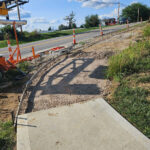Summer 2024 – KEM in the News
KEM in the News
GOPC Active Transportation Update (mailchi.mp)

KEM Project Recognized by Greater Ohio Policy Center
Greater Ohio Policy Center (GOPC) is excited to share with you our newly published guide How to Build Safe, Vibrant Streets in Ohio: A Guide for Non-Engineers. The guide provides tips for implementing active transportation projects, sources of funding for projects communities in Ohio can access, and technical assistance that can help plan and fund projects at the state and federal level.
At the heart of the guide are six case studies that feature active transportation projects in communities throughout Ohio. The projects, which range from modest in scale to complete overhauls of a district streetscape, show how cities in Ohio are working collaboratively to address local needs.
The six communities profiled are:
Xenia Protected Bike Lane
In Xenia, the city implemented a series of safety improvements in downtown, including a protected bike lane, that connects Xenia’s downtown to a larger regional trail network. At a cost of $1.5 million, the city was able to add one protected bike lane, expand a key median, and undertake other intersection improvements.
Columbus Summit Street Cycle Track
Columbus leaders took the opportunity created by a routine resurfacing project to completely redesign a major urban corridor. Summit Street now has Ohio’s first cycle-track bike lanes. At a cost of $7 million, the project included the construction of one protected cycle-track and associated infrastructure, and one unprotected bike lane on a parallel street.
Mansfield Downtown Redevelopment
A multi-year economic development campaign led community members and city leaders in Mansfield to embark on an effort to make the Main Street corridor more welcoming and pedestrian friendly. Layering federal, state, local, private, and public public funds, the $27.1 million project will include streetscaping, street conversions (one-way to two-way traffic) and a downtown park restoration.
Youngstown Downtown Redesign
Youngstown is completing a major infrastructure overhaul in the core of the city’s downtown, including narrowing streets and widening sidewalks to better connect downtown’s people and assets. With a $12 million budget, the project incorporates complete street elements on five downtown streets, as well as a new autonomous shuttle.
Bexley Bike/Ped Investment
Over the past twenty years, the inner-ring suburb of Bexley has invested significantly in cycling and pedestrian infrastructure improvements to make the city safer for all road users of all types of modes. To date, the city has invested over $12 million on streetscape improvements and bike paths.
Lorain Collaborative Impact Model
Lorain has implemented an Active Transportation plan through the collaboration of agencies and nonprofits coming together to propel a shared vision for health and safety. Investing $4 million to date, the projects include a bike share program, 1 bike lane, sidewalk and intersection improvements, and a shuttle service.
The Active Transportation guide How to Build Safe, Vibrant Streets in Ohio: A Guide for Non-Engineers, shows that communities around Ohio are making changes to street designs to improve their communities for pedestrians, cyclists, people in wheelchairs or strollers. The projects are being implemented for the benefit of individual residents, but there are clear economic benefits to the communities as well. These projects are creating vibrant downtowns, neighborhood districts, and community gathering spaces.

A Main Street road to improvement that began six years ago in Austin, Texas, cleared its last legislative hurdle at Mansfield City Council on Tuesday night.
The conception of a $17 million Main Street Corridor Improvement Plan began in 2018 during the annual South by Southwest conference, attended by a group of 15 local residents as part of the initial Mansfield Rising project.
The basic tenets of Mansfield Rising, a downtown reinvestment plan, was to dramatically improve the downtown’s attractiveness and abilities in terms of business, gathering and living.
The Main Street Corridor Improvement Plan was seen as a key element in that effort, according to officials, who worked with K.E. McCartney & Associates to write an application for the federal Rebuilding American Infrastructure with Sustainability and Equity competitive grant program.
That effort led to an announcement in 2022 that the city would receive a $7.3 million federal RAISE grant for the project, which local lawmakers officially accepted Tuesday night, along with other final funding sources.
City engineer Bob Bianchi told council the project now has 14 funding sources, including federal, state and local dollars. About 80 percent of the funds needed for the project are not local tax dollars.
Council on Tuesday officially authorized the city to seek bids for the project, scheduled to begin in February and be complete by October 2026. The work will be done in stages to lessen the impact along the entire corridor from First Street to Sixth Street.
“It’s been a long process and we’re there and we believe we’ve got all the funds necessary to do the project,” Bianchi said.
Actual construction costs are estimated at $15.6 million with another $1.4 million for construction inspection, he said.
“I anticipate having a (contract) awarded in early January, maybe even in December. We’ll then know the contractor and we’ll start setting up for preconstruction meetings and construction will start. Our goal is February 2025,” he said.
The project includes a complete upgrade from Main Street from First to Sixth streets and Park Avenue from Main to Diamond streets.
The project involves replacing water mains, storm sewers, streetscape amenities, streetscape furnishings, decorative hardscape, sidewalks, curb ramps, signals, landscaping and lighting, Bianchi said.
The north and south plazas will be fully renovated, including fountain reconstruction.
He said new installations, such as mid-block pedestrian crossings, seating and decorative walls/fencing, brick crosswalks, brick hardscape, traffic control devices, irrigation, fiber, wayfinding signage and two decorative arches are included in the project.
Bianchi said road resurfacing and pavement striping will be done as Main Street is converted to two-way traffic.

 Previous Post
Previous Post Next Post
Next Post